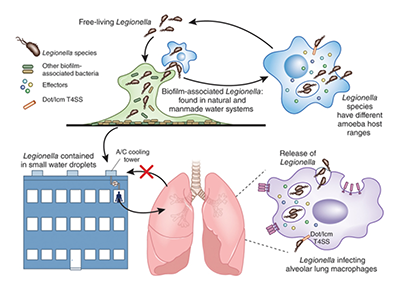The interrelationship between Legionella bacteria, amoeba, organic contamination and water in cooling towers and fountains can produce a severe pneumonia called legionnaires’ disease. In this summary we will review the lifecycle of Legionella bacteria, review the effects of ProMoss™ on organic contamination, and discuss the results of Legionella testing on cooling towers treated with ProMoss™ in the state of New York.
The Legionella Lifecycle
As shown in the accompanying diagram taken from this article, Legionella bacteria, along with amoeba, live in the organic contamination on the surfaces of water systems. It is interesting to note that Legionella do not grow like other bacteria. Legionella can only grow when they are inside another cell. Amoeba are single cell organisms that usually eat bacteria and organic contamination as their food source. When amoeba eat Legionella, the bacteria become encapsulated normally, but these capsules never come in contact with the enzymes that usually destroy them so they can become food for the amoeba. The Legionella continue to grow inside the amoeba and are either released from the diseased amoeba into the water or a cyst containing the Legionella bacteria is released. In this form, the bacteria can be aerosolized and inhaled into a human host.
In the human, the cycle happens again, but this time instead of the amoeba being the infected cell it is a lung immune cell that tries to eat the Legionella. But just like in the amoeba, the bacteria live and thrive inside the cysts. As the bacteria divide and infect more and more immune cells, the bacteria spread and cause pneumonia that is very difficult to treat.
ProMoss™ and Legionnaires Disease
We know that ProMoss™ inhibits the formation and removes organic contamination. Without organic contamination, amoeba can’t eat and don’t survive. Without the amoeba, the Legionella bacteria can’t survive. One of the reasons that controlling Legionella with chemicals is difficult is because biocides are absorbed into organic contamination, and the usual level of biocide used in cooling towers is totally ineffective against amoeba. To kill amoeba requires high levels of biocide for long periods of time. Two of the most effective biocides against amoeba are ozone and hydrogen peroxide.
Experience with Legionella Testing in New York State
Mike Bromley, from Water Wise of America, Inc., a CWS dealer in New York, has over 25 cooling towers on ProMoss™ using hydrogen peroxide as the biocide. In the state of New York, it is required to obtain Legionella colony counts for cooling towers every three months. If the levels are greater than 20 colony forming units per mL (CFU/mL), the tower needs to be disinfected and retested. If there are greater than 1000 CFU/mL the tower needs to be decontaminated and retested. If it is greater than 1000 CFU/mL a second time, it has to be drained, decontaminated, refilled and retested until the Legionella level is lower than 20 CFU/mL. There have been two cooling towers using ProMoss™ that have tested positive for greater than 20 CFU/mL. They were both disinfected and retested with no Legionella present at the next test or thereafter. None of the other towers on ProMoss™ have tested positive for Legionella.
Legionnaires’ Disease Prevention
The use of ProMoss™ along with an approved biocide is shown to be very effective in maintaining cooling towers free from Legionella infestation. The combination of ProMoss™ with hydrogen peroxide generation provides a totally chemical free system.
